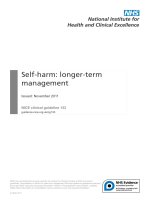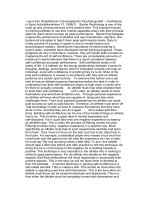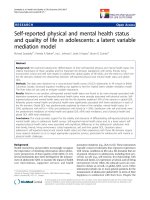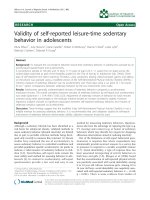Prof p hazell self harm in adolescents hanoi
Bạn đang xem bản rút gọn của tài liệu. Xem và tải ngay bản đầy đủ của tài liệu tại đây (1.09 MB, 39 trang )
Self harm in
adolescents
Professor Philip Hazell
Rivendell Child Adolescent and
Family Mental Health Service
1
General considerations
Continuum of seriousness
Continuum of intent to die (may be as low as 0.2%)
Common precipitant is conflict with parents or
significant others
‘Contagion’ effect
Small group account for large proportion of
repetitions
Poor adherence to follow up, but those with greater
risk of repetition more likely to attend
2
Overlapping Terminologies
Non-suicidal self injury
Restricted to external injury, no suicide intent
Deliberate self harm
Inclusive of internal injury ie ingestion, agnostic about suicide
intent
Parasuicide
As for DSH plus aimed at realising changes which the subject
desired via the actual or expected physical consequences
Attempted suicide
A more specific subcategory of parasuicide characterised by a
strong intention to die
Self poisoning, self mutilation, self battery, self immolation
Self injurious behaviour
3
Frequency of self-harm types
Clinically referred sample 12-16 yrs
Hazell et al. J Am Acad Child Adolesc Psychiatry 2009;48:662-670
Cutting
97%
Head banging
71%
Medication overdose 57%
Smothering
36%
Strangling
25%
Other poisoning
19%
Jumping from height 17%
Other
35%
4
Method of self-harm by gender
Madge et al. J Child Psychol Psychiatry 2008;49:667-77
5
Four-week prevalence of non-suicidal
self injury by age and sex
Martin et al. Australian National Epidemiological Study of Self Injury
6
Rates of self-harm by gender in 15
and 16 yr olds
Madge et al. J Child Psychol Psychiatry 2008;49:667-77
7
Repetition (‘more than once’)
Community aged 15-16 yrs
Madge et al. J Child Psychol Psychiatry 2008;49:667-77
Males
53.2%
Females 55.4%
Cutting more likely than other methods to be
associated with repetition
8
Pattern of self-harm over 12 months
Referred sample 12-16 yrs
Hazell et al. Presentation to AACAP meeting, Honolulu, Oct 2009
NC21
Yes
No
No
Yes
NC22
No
No
No
No
NC23
No
Yes
Yes
NC24
Yes
Yes
Yes
Yes
NC25
Yes
Yes
Yes
Yes
999
Yes
Yes
No
No
Yes
No
No
interm
i
t
No
No
No
No
No
No
No
No
atten
Yes
No
No
No
No
No
No
No
atten
Yes
Yes
Yes
Yes
persis
t
Yes
Yes
No
999
999
Yes
Yes
Yes
99
Yes
999
No
Yes
persis
t
9
Self injury
Age of onset
12-14 yrs (based on retrospective data)
Course
Variable, most have ceased within 5 yrs of starting
10
Motives for self-harm
Community 15-16 yrs
Madge et al. J Child Psychol Psychiatry 2008;49:667-77
11
Setting for self harm
Community aged 15-16 yrs
Madge et al. J Child Psychol Psychiatry 2008;49:667-77
The majority of self-harm episodes (83.3%)
occurred at home
12
Figure 1. Location of suicide attempts made by adolescents
aged 17 years and under in Oregon 1988-1993
Jail
7 (0.2%)
Other
337 (9%)
School
178 (4.7%)
Another residence
280 (7.4%)
Home
2981 (79%)
13
Figure 2. Time of arrival at emergency department of
adolescent suicide attempters in Perth, Western Australia
0600-1159
14 (8%)
0000-0559
39 (23%)
1200-1759
45 (26%)
1800-2359
75 (43%)
Adapted with permission from Youth Suicide Steering Committee report to
Health Department of Western Australia (Silburn et al., 1991)
14
Alcohol and drugs
Community aged 15-16 yrs
Madge et al. J Child Psychol Psychiatry 2008;49:667-77
One in five self-harm episodes (19.9%) occurred
under the influence of alcohol, and one in eight
(12.8%) under the influence of illegal drugs. In both
cases this was more likely for males than females.
15
Associations with self injury
Community sample all ages
Martin et al. Australian National Epidemiological Study of Self Injury
Suicidal ideation
Impulsivity
Substance misuse
Neglect or maltreatment prior to age 18 yrs
16
Pubertal stage and self-harm
Community 12-15 yrs
Patton et al. Journal of the American Academy of Child & Adolescent
Psychiatry 2007;46:508-14.
17
Puberty and self harm
Advance in puberty associated with greater risk of self-harm
The association with pubertal stage was evident in boys but
appeared more striking in girls in whom self-laceration and selfpoisoning constituted the great proportion of self-harm from late
puberty.
Being older was associated with lower risks of self-harm.
Early maturers are at higher risk of self-harm because they enter
puberty at an earlier point and do not have the reduction in risk
that comes with older age.
18
Is self injury contagious?
19
A pilot study of adolescent
friendship networks
and self harm
Philip L. Hazell, PhD, FRANZCP
Terry J. Lewin, B Com (Psych)
Natalia T. Carter, B Sc (Hons)
20
Method: Seven adolescent self harmers and four
non harming adolescent psychiatric outpatients
nominated their friends, who were assessed at 0, 3
and 6 months on measures of psychiatric morbidity,
suicidal ideation and behavior, depression, drug
use, family functioning, and life events. Friendship
networks were characterized in terms of overlap and
intensity of relationships.
21
Results
There was greater overlap in the friendship networks of friends of
controls compared with friends of self harmers.
Forty-five percent of friends of self harmers harmed themselves
during the follow-up period compared with 10% of friends of
controls.
Friends of self harmers had higher rates of suicidal ideation,
depressive symptoms, externalizing and internalizing symptoms
compared with friends of controls, but there was no evidence of
new onset problems.
Greater support from the focal adolescent was associated with
greater levels of disturbance in the friends.
22
Conclusions
Friends of adolescent self harmers are at risk of
self-harm and depression, the data favoring
assortive friendships as the primary mechanism.
There is a “dose” effect, with the intensity of the
relationship increasing risk for disturbance.
23
Special populations:
Psychiatric inpatients
Contagion reported eg Turku study
Contributing factors were overcrowding, high
numbers of patients with borderline traits, periods of
low activity, low supervision
I would add looked after children, trauma, neglect
24
Special populations:
Goths and Emos
25









